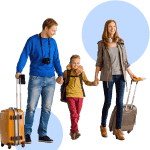Plan your Kenyan Tour and Trip Comfortably - Best Advice

Preparing for a safari trip to Kenya means weighing a lot of factors that might take a lot of your time. Why not talk to a resourceful local consultant like Homejoy Safari Adventures & get set up smoothly for your Kenya Safari tour?



Ensure to Make new discoveries and learn new things
How to Get Around Kenya: Domestic Flights, Car Rentals, and Public Transport
Nairobi, Nairobi County
Kenya
Exploring Kenya requires an understanding of its diverse transport options. Whether you're a first-time visitor or a seasoned traveler, navigating Kenya’s transport system efficiently enhances your travel experience. From fast domestic flights to self-driven car rentals and budget-friendly public transport, each option has unique advantages suited to different types of travelers. Kenya is home to world-renowned safari destinations, breathtaking coastlines, and vibrant urban centers. Knowing the best way to travel between these locations is essential for a smooth and enjoyable trip. While some tourists prefer the convenience of flights, others may opt for the freedom of renting a vehicle or the affordability of local transport. Planning ahead and selecting the best transport option based on itinerary, budget, and safety considerations can greatly enhance your travel experience. For those planning to visit Kenya’s popular safari destinations such as Maasai Mara, Amboseli, or Tsavo, domestic flights provide a time-efficient option. Scheduled flights from Nairobi to major safari locations eliminate long hours on the road, ensuring travelers can maximize their time on game drives rather than spending hours in transit. Moreover, flights to coastal towns like Mombasa and Malindi allow visitors to enjoy Kenya’s stunning beaches without enduring long, tiring road journeys. On the other hand, renting a car offers travelers the flexibility to explore off-the-beaten-path destinations. Whether it’s a scenic road trip through the Great Rift Valley or a self-drive experience in Laikipia, having a personal vehicle allows tourists to control their itinerary without relying on fixed schedules. Car rentals are especially useful for visitors planning to explore multiple regions or national parks. However, road conditions vary, with some areas requiring a 4x4 vehicle, especially during the rainy season. For budget-conscious travelers or those who want to experience the local culture more closely, public transport provides an affordable and immersive way to get around. Matatus (shared minibuses) and boda-bodas (motorbike taxis) are commonly used by locals for short trips, while long-distance buses such as Modern Coast and Easy Coach provide comfortable and economical travel between cities. However, tourists using public transport should be cautious of safety concerns, overcrowding, and varying levels of reliability. This guide covers three major transport modes in Kenya: domestic flights for quick and efficient travel, car rentals for flexibility and independence, and public transport for budget-conscious explorers. Understanding the pros and cons of each mode ensures that travelers can navigate Kenya with confidence, maximizing both comfort and adventure while exploring the country’s stunning landscapes and diverse attractions.
Airlines and Destinations in Kenya
| Airline | Destinations |
|---|---|
| Jambojet | Nairobi, Mombasa, Kisumu, Malindi, Diani |
| Safarilink | Maasai Mara, Amboseli, Diani, Samburu |
| AirKenya | Amboseli, Maasai Mara, Nanyuki |
Navigating Kenya: Understanding Your Transport Options
 Kenya's vast and diverse landscapes require efficient transportation for travelers exploring beyond Nairobi. Whether you're heading to the Maasai Mara, the coastal beaches of Diani, or Mount Kenya, understanding the best transport methods is essential. Traveling across Kenya presents unique challenges and opportunities. The country has a mix of well-developed infrastructure in urban areas and rougher terrain in remote locations, which affects the choice of transport. For instance, a journey from Nairobi to the Maasai Mara requires a four-wheel drive vehicle. At the same time, a trip to the coast like the coastal getaways in Diani Beach is best accessed via domestic flights or comfortable long-distance buses. The choice of transport depends on several factors, including budget, convenience, safety, and the type of experience a traveler seeks. Domestic flights are the fastest and most convenient option for long distances, particularly for those traveling to remote safari destinations. Airlines like Jambojet and Safarilink operate scheduled flights that cut travel time significantly. However, flights can be costly compared to other transport options. For those who prefer independence, renting a car provides the flexibility to explore at one’s own pace. Kenya’s road network connects most major tourist destinations, making road trips an attractive option. However, road conditions vary, with some routes requiring a 4x4 vehicle due to rough and unpaved roads. Car rentals are available from international and local providers, with options to include a driver who understands local road conditions and regulations. Public transport remains the most budget-friendly mode of travel in Kenya, but it comes with trade-offs. Matatus (shared minibuses) are the most commonly used means of transport for short to medium distances. They are affordable but can be overcrowded and less reliable in terms of safety and adherence to schedules. Long-distance buses offer a more structured alternative, with companies like Modern Coast and Easy Coach providing relatively comfortable services between major towns. Motorbike taxis (boda-bodas) and tuk-tuks are ideal for short distances, especially in towns and rural areas, though they require caution due to higher accident risks. Understanding Kenya’s transport options helps visitors make informed decisions about their travel plans. Whether choosing speed and convenience with flights, flexibility with car rentals, or affordability with public transport, planning is key to ensuring a smooth and enjoyable trip. By selecting the best mode of transport for each leg of their journey, travelers can experience Kenya’s diverse attractions in a hassle-free manner.
Kenya's vast and diverse landscapes require efficient transportation for travelers exploring beyond Nairobi. Whether you're heading to the Maasai Mara, the coastal beaches of Diani, or Mount Kenya, understanding the best transport methods is essential. Traveling across Kenya presents unique challenges and opportunities. The country has a mix of well-developed infrastructure in urban areas and rougher terrain in remote locations, which affects the choice of transport. For instance, a journey from Nairobi to the Maasai Mara requires a four-wheel drive vehicle. At the same time, a trip to the coast like the coastal getaways in Diani Beach is best accessed via domestic flights or comfortable long-distance buses. The choice of transport depends on several factors, including budget, convenience, safety, and the type of experience a traveler seeks. Domestic flights are the fastest and most convenient option for long distances, particularly for those traveling to remote safari destinations. Airlines like Jambojet and Safarilink operate scheduled flights that cut travel time significantly. However, flights can be costly compared to other transport options. For those who prefer independence, renting a car provides the flexibility to explore at one’s own pace. Kenya’s road network connects most major tourist destinations, making road trips an attractive option. However, road conditions vary, with some routes requiring a 4x4 vehicle due to rough and unpaved roads. Car rentals are available from international and local providers, with options to include a driver who understands local road conditions and regulations. Public transport remains the most budget-friendly mode of travel in Kenya, but it comes with trade-offs. Matatus (shared minibuses) are the most commonly used means of transport for short to medium distances. They are affordable but can be overcrowded and less reliable in terms of safety and adherence to schedules. Long-distance buses offer a more structured alternative, with companies like Modern Coast and Easy Coach providing relatively comfortable services between major towns. Motorbike taxis (boda-bodas) and tuk-tuks are ideal for short distances, especially in towns and rural areas, though they require caution due to higher accident risks. Understanding Kenya’s transport options helps visitors make informed decisions about their travel plans. Whether choosing speed and convenience with flights, flexibility with car rentals, or affordability with public transport, planning is key to ensuring a smooth and enjoyable trip. By selecting the best mode of transport for each leg of their journey, travelers can experience Kenya’s diverse attractions in a hassle-free manner.
Which are the fastest Domestic Flights in Kenya
Domestic flights offer the quickest and most convenient means of traveling long distances in Kenya. With well-established airlines such as Kenya Airways, Jambojet, and Safarilink, tourists can access key destinations efficiently. Flying domestically saves time, allowing travelers to maximize their exploration opportunities without spending hours on the road. Kenya has a well-developed domestic air network with key airports in major cities and tourist destinations. Nairobi’s Jomo Kenyatta International Airport and Wilson Airport serve as the main hubs for domestic flights, offering connections to coastal cities such as Mombasa, Malindi, and Lamu, as well as safari destinations like the Maasai Mara and Amboseli National Park. Regional airports in Kisumu, Eldoret, and Nanyuki further enhance accessibility across the country. Many domestic flights cater to safari travelers, providing direct access to airstrips within national parks and game reserves. This eliminates the need for long, bumpy drives on rough roads and enhances the overall safari experience. Flying into the Maasai Mara, for instance, takes about 45 minutes compared to a 5–6 hour drive. Tourists can also enjoy stunning aerial views of Kenya’s landscapes, including the Great Rift Valley and the expansive savannahs. When booking a domestic flight in Kenya, travelers should consider factors such as baggage allowance, flight schedules, and seasonal demand. Budget airlines like Jambojet and Fly540 provide affordable options with frequent departures, while premium services like Safarilink and AirKenya offer flights directly to remote lodges and conservancies. Security and safety standards at Kenyan airports align with international protocols, ensuring a smooth and hassle-free experience for travelers. Booking flights in advance is recommended, especially during peak tourist seasons, to secure the best rates and preferred departure times. Travelers should also be aware of weight restrictions on smaller aircraft, particularly those flying to safari destinations, where baggage allowances may be lower due to aircraft size limitations. Ultimately, domestic flights offer a seamless travel option for those looking to maximize their time and convenience while exploring Kenya’s diverse attractions. With several airlines providing efficient services to key destinations, flying remains a preferred choice for leisure and business travelers visiting with MICE tour packages in the country. Many flights operate from Wilson Airport, the hub for safari and regional flights. While domestic flights are more expensive than other options, they save significant travel time.
Are there Car Rentals in Kenya
Renting a car in Kenya provides flexibility, especially for tourists exploring remote areas. It allows visitors to create personalized itineraries, travel at their own pace, and access locations that may be difficult to reach by public transport. This is particularly beneficial for those visiting Kenya’s national parks, scenic landscapes, and cultural heritage sites. Foreign visitors need an international driver’s permit or a valid license from their country. Some rental companies may require additional documentation, such as a passport and proof of insurance. It’s also important to check if the rental company provides unlimited mileage or has restrictions on the distance traveled. Kenya’s road network is extensive, but road conditions can vary greatly. In major cities like Nairobi and Mombasa, roads are generally well-maintained, though traffic congestion is common. Rural roads, particularly those leading to safari destinations and remote villages, can be challenging due to rough terrain and unpaved surfaces. This makes choosing the right vehicle essential.
Types of Rental Vehicles:
-
Compact Cars: Ideal for city travel and short distances on well-paved roads.
-
SUVs & 4x4 Vehicles: Recommended for safaris and rural adventures due to rough road conditions.
-
Luxury Vehicles: Available for business travelers and those seeking comfort.
-
Camper Vans: A great option for overland travelers exploring multiple destinations independently.
Best Car Rental Practices:
- Choose a 4x4: Essential for game drives and rural roads where conditions may be challenging.
- Understand Insurance Policies: Verify comprehensive coverage, including third-party liability, theft protection, and collision damage waivers.
- Opt for a Driver: Local drivers are experienced with road conditions and traffic rules, which can enhance safety and navigation.
- Check Vehicle Condition: Inspect the car before rental and report any damage to avoid liability upon return.
- Plan Fuel Stops: Gas stations can be sparse in remote areas, so it’s advisable to refuel before long drives.
Renting from reputable companies like Hertz, Europcar, or local providers ensures vehicle reliability. Many companies offer chauffeur services for those who prefer not to drive themselves. Homejoy Safari Adventures offers tailored rental services, ensuring tourists have the right vehicle for safaris or city exploration, complete with expert drivers and guides. While renting a car in Kenya provides convenience and independence, it is important to be aware of local driving laws and safety measures. By following best practices and selecting the right vehicle, visitors can enjoy a seamless and adventurous travel experience across Kenya’s diverse landscapes.
Explore the Public Transport: Budget-Friendly but Unpredictable
Kenya’s public transport system includes matatus (shared minibuses), buses, and boda-bodas (motorbike taxis). Public transport is the most affordable way to travel, but it comes with challenges such as safety concerns, varying reliability, and comfort levels that may not always meet international standards. Matatus are the most popular mode of transport for short to medium distances in urban and peri-urban areas. These privately owned minibuses operate on fixed routes and can be found almost everywhere in Kenya. They are inexpensive, making them an attractive option for travelers on a budget. However, matatus often exceed passenger capacity, and some drivers may not always adhere to traffic laws, which raises safety concerns. Despite these drawbacks, many travelers use matatus for their efficiency and widespread availability. For those traveling longer distances, buses offer a more structured alternative and through our tour consultancy services, we help you book with companies like Modern Coast, Easy Coach, and Mash Poa provide intercity and long-distance travel across major towns. These buses are more reliable than matatus, offer scheduled departures, and often come with amenities such as air conditioning and reclining seats. However, delays can occur due to traffic congestion and occasional mechanical issues. Tourists are advised to book tickets in advance for premium services to ensure a comfortable journey. Boda-bodas (motorbike taxis) and tuk-tuks (three-wheeled taxis) are widely used for short-distance travel, particularly in congested urban areas and rural settings. Boda-bodas provide quick transportation but come with higher safety risks due to their high-speed maneuvering in traffic. Tuk-tuks, on the other hand, offer a slightly safer alternative, being more stable than motorbikes. Both options are suitable for quick trips, but travelers should always wear helmets and negotiate fares before starting a ride. The reliability of Kenya’s public transport varies. While buses generally follow set schedules, matatus and boda-bodas operate on a more informal system, meaning that passengers may have to wait for vehicles to fill up before departure. Additionally, fare prices can fluctuate based on demand, fuel costs, and route changes. For tourists who prefer more convenience and safety, ride-hailing services such as Uber, Bolt, and Little Cab are available in major cities like Nairobi, Mombasa, and Kisumu. These services provide a safer and more comfortable alternative to matatus and boda-bodas, though they are more expensive. Overall, public transport in Kenya is an economical way to get around, but travelers should be cautious and plan accordingly. While it provides easy access to different parts of the country, visitors must weigh the trade-offs between cost, comfort, and safety. By selecting the right mode of public transport based on their itinerary, tourists can enjoy an authentic and immersive Kenyan travel experience. Matatus are inexpensive but may lack safety regulations. Long-distance buses like Modern Coast and Easy Coach offer comfortable travel between major towns.
FAQ About How to Get Around Kenya
-
What’s the easiest way to travel around Kenya? The easiest way to travel around Kenya depends on distance and budget. Domestic flights are ideal for long distances, car rentals provide flexibility, and public transport is the most affordable option.
-
How much do domestic flights cost in Kenya?Prices for domestic flights in Kenya vary by destination and airline. Budget airlines like Jambojet offer fares starting from $50, while premium flights to safari destinations can cost up to $300.
-
Is public transport in Kenya safe for tourists?Public transport varies in safety. Buses and ride-hailing services are generally safer than matatus. Tourists should use reputable services and avoid traveling at night.
-
Can I rent a car in Kenya as a tourist?Yes, tourists can rent cars in Kenya with a valid foreign or international driver’s permit. Booking through reputable agencies ensures reliability and safety.
-
What’s the fastest way to get from Nairobi to the coast?Flying is the fastest option, with flights from Nairobi to Mombasa taking about an hour. The SGR train is another efficient alternative, taking around 5 hours.
-
Are taxis and ride-hailing services available in Kenya?Yes, Uber, Bolt, and Little Cab operate in major cities like Nairobi and Mombasa, offering safe and convenient travel.
-
Do tourists need a 4x4 vehicle in Kenya?A 4x4 is recommended for visiting national parks, remote areas, or during the rainy season. For city travel, a regular car is sufficient.
-
What are the most affordable transport options in Kenya?Matatus and long-distance buses are the most budget-friendly options. Ride-hailing services offer a balance between cost and safety.